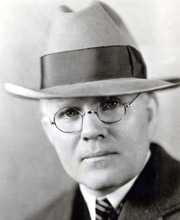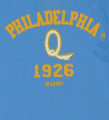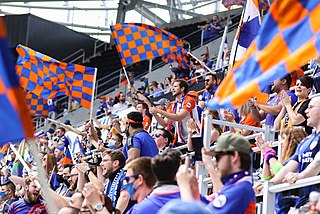Related Research Articles
Buffalo, New York had a turbulent, early-era National Football League team that operated under multiple names and several different owners between the 1910s and 1920s. The early NFL-era franchise was variously called the Buffalo All-Stars from 1915 to 1917, Buffalo Niagaras in 1918, the Buffalo Prospects in 1919, Buffalo All-Americans from 1920 to 1923, Buffalo Bisons from 1924 to 1925 and in 1927 and 1929, and the Buffalo Rangers in 1926. The franchise, which was experiencing financial problems in 1928, did not participate in league play that season.
Detroit had four early teams in the National Football League before the Detroit Lions. The Heralds played in 1920, and had played as an independent as far back as 1905. The Tigers, a continuation of the Heralds, played in 1921, folding midseason and sending their players to the Buffalo All-Americans. The Panthers competed from 1925 to 1926 and the Wolverines in 1928.
The Cleveland Tigers were the first Cleveland team franchise in what became the National Football League (NFL). The Tigers played in the "Ohio League" before joining the American Professional Football Association during the 1920 and 1921 seasons.
The Columbus Panhandles were a professional American football team based in Columbus, Ohio. The club was founded in 1901 by workers at the Panhandle shops of the Pennsylvania Railroad. They were a part of the Ohio League from 1904 before folding after one season. Three years later, the team tried again, playing in the Ohio League from 1907 to 1919, not winning a championship, before becoming charter members of the American Professional Football Association (APFA) which became the National Football League (NFL).
Louisville, Kentucky had two professional American football teams in the National Football League: the Louisville Breckenridges from 1921 to 1924 and the Louisville Colonels in 1926.

The Oorang Indians were a traveling team in the National Football League from LaRue, Ohio. The franchise was a novelty team put together by Walter Lingo to market his Oorang dog kennels. All of the Indians players were Native American, with Jim Thorpe serving as its leading player and coach. The team played in the National Football League in 1922 and 1923. Of the 20 games they played over two seasons, only one was played at "home" in nearby Marion. With a population well under a thousand people, LaRue remains the smallest town ever to have been the home of an NFL franchise, or probably any professional team in any league in the United States.

The Rock Island Independents were a professional American football team, based in Rock Island, Illinois, from 1907 to 1926. The Independents were a founding National Football League franchise. They hosted what has been retrospectively designated the first National Football League game on September 26, 1920 at Douglas Park. The Independents were founded in 1907 by Demetrius Clements as an independent football club. Hence, the team was named the "Independents."

Joseph Francis Carr was an American sports executive in football, baseball, and basketball. He is best known as the president of the National Football League from 1921 until 1939. He was also one of the founders and president of the American Basketball League (ABL) from 1925 to 1927. He was also the promotional director for Minor League Baseball's governing body from 1933 to 1939, leading an expansion of the minor leagues from 12 to 40 leagues operating in 279 cities with 4,200 players and attendance totaling 15,500,000.
Throughout the years, a number of teams in the National Football League (NFL) have either moved or merged.

The Philadelphia Quakers were a professional American football team that competed in the first American Football League in 1926 and won the league's only championship.
The first American Football League (AFL), sometimes called AFL I, AFLG, or the Grange League, was a professional American football league that operated in 1926. It was the first major competitor to the National Football League (NFL). Founded by Charles "C.C." Pyle, (1882–1939), and General Charles X. Zimmerman, (1865–1926), as vice president and starring Hall of Fame halfback Harold Edward "Red" Grange, (1903–1991), the short-lived league with nine teams competed against the more established – then six-year-old – NFL, both for players and for fans. While Pyle's and Grange's New York Yankees team and the already established Philadelphia Quakers became reliable draws, the lack of star power and the uncertain financial conditions of the other seven teams led to the league's dissolution after one season.
In athletics terminology, barnstorming refers to sports teams or individual athletes who travel to various locations, usually small towns, to stage exhibition matches. The term is primarily used in the United States. Barnstorming teams differ from traveling teams in that they operate outside the framework of an established athletic league, while traveling teams are designated by a league, formally or informally, to be a designated visiting team.
The 1926 AFL season is the only season of the first American Football League. It started with nine teams, with the initial game of the season being played in front of 22,000 fans in Cleveland, Ohio, but by the end of the season, only four teams were still in existence: three teams owned or subsidized by league founder C. C. Pyle and star Red Grange and league champion Philadelphia Quakers. The initial lineup of teams included the traveling Wildcats and a charter member of the National Football League, the Rock Island Independents, which became a second traveling team after having poor attendance in its first three games.
The Pacific Coast Professional Football League (PCPFL), also known as the Pacific Coast Football League (PCFL) and Pacific Coast League (PCL) was a professional American football minor league based in California. It operated from 1940 through 1948. One of the few minor American professional sports leagues that competed in the years of World War II, the PCPFL was regarded as a minor league of the highest level, particularly from 1940 to 1945, at a time in which the National Football League (NFL) did not extend further west than Chicago and Green Bay. It was also the first professional football league to have a team based in Hawaii.
The Los Angeles Wildcats was a traveling team of the first American Football League that was not based in its nominal home city but in Chicago, Illinois. Coached by Jim Clark, the team was designed to be a showcase for University of Washington star back George “Wildcat” Wilson. Compared to most traveling teams in professional football, the Wildcats were successful, compiling a 6–6–2 record in the only season of the team's – and the league's – existence.
The Cleveland Panthers were a professional American football team. They were an independent team founded in 1919 from the remains of the Youngstown Patricians. The Panthers played, with various degrees of success, continuously from 1919 and eventually, as fewer opponents played them each year after 1926, sputtered to a quiet folding in 1933.
The 1934 edition of the American Football League was a short-lived professional american football minor league with teams based in the American South and Southwest. The first of several minor leagues with the same name, the 1934 was also one of the first involving teams not located in the American Midwest and East. While its membership was the cornerstone of American football in the southern U.S., the AFL had only one season of competition and folded after cancelling competition in the 1935 season.

Douglas Park is a public park located at 18th Avenue and 10th Street in Rock Island, Illinois. A former National Football League venue, Douglas Park was the site of the first-ever National Football League game on September 26, 1920. The Rock Island neighborhood that is today called Douglas Park dates back to the 1830s, with the athletic park being constructed in 1904 to 1905 and utilized for football beginning in 1907.

Ohio is home to many professional and college sports teams. The metropolitan areas of Cleveland, Cincinnati, and Columbus are home to major league professional sports teams in baseball, basketball, football, hockey, and soccer.
References
- ↑ David S. Neft, Richard S. Cohen, and Rick Korch, The Football Encyclopedia: The Complete Year-By-Year History of Professional Football From 1892 to the Present (St. Martin's Press 1994) ISBN 0-312-11435-4
- ↑ Race and Sport: The Struggle for Equality on and off the Field ISBN 1-57806-897-5
- ↑ Last Team Standing: How the Steelers and the Eagles – "The Steagles" – Saved Pro Football During World War II ISBN 0-306-81472-2
- ↑ Los Angeles Football Story from nfl.com
- ↑ Pigskin: The Early Years of Pro Football ISBN 0-19-511913-4
- ↑ Total Football II: The Official Encyclopedia of the National Football League ISBN 0-06-039232-0
- ↑ The Landry Legend: Grace Under Pressure ISBN 0-8499-0728-4
- ↑ Las Vegas loses CFL team. New York Times. October 22, 1994.